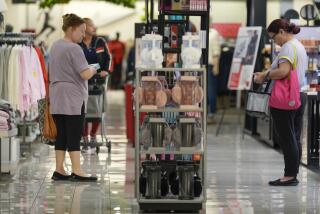Inventories’ Sharp Jump of 0.7% Is Taken in Stride
- Share via
WASHINGTON — Business inventories rose sharply relative to sales in September, a sign of economic weakness, but analysts discounted the significance of Wednesday’s government report, noting that sales have picked up since then.
The Commerce Department said inventories held on shelves and back lots rose 0.7% to a seasonally adjusted $749.4 billion, while sales remained virtually unchanged at $495.4 billion.
The combination of rising inventories and flat sales can foretell an economic slowdown. If the trend continued, retailers would order fewer goods, leading to production cutbacks and layoffs at manufacturing plants.
However, business sales have been generally strong this year and economists said sales have kept pace with inventory gains in most months.
The September inventory increase, the 21st in a row, followed a large 1.1% gain in August and a 0.7% rise in July. The last decline was in December, 1986.
The flat September sales snapped a string of nine consecutive increases. They shot up 1.3% in August and rose a slight 0.1% in July.
“It was a large jump in inventories in relation to sales . . . but it does not suggest to me that we have as yet any broad-based excesses,” said Allen Sinai, chief economist of the Boston Co. “Retail inventories are getting a little fat, but by and large the situation remains well under control.”
Inventory accumulation in September was led by a substantial 1.5% rise at the retail level, where sales were the weakest. However, much of the increase was attributed to a 4.9% jump at auto dealers. Excluding autos, retail inventories were up a much smaller 0.3%.
Wholesale inventories rose only 0.1%, while inventories at factories increased 0.6%.
In sales, a 0.1% dip at manufacturing plants and a 0.3% decline at retail stores offset at 0.5% increase at the wholesale level. Sales have been particularly strong at the manufacturing level this year because of an export boom fueled by the lower value of the dollar.
An advance estimate of retail sales for October, released Tuesday, showed a strong 0.9% gain, evidence that the accumulation of inventories may have moderated somewhat as the fourth quarter began.
Drop in Ratio Expected
Also, U.S. auto companies reported Tuesday that sales of cars and light trucks during the first 10 days of November were up 14.9% from a year ago.
The combination of an increase in inventories and steady sales left the inventory-to-sales ratio at 1.51 in September, up from 1.50 during the three previous months. That means it would take 1.51 months to exhaust inventories at the September sales pace, a ratio not considered unusually high.
“Given the strong sales in October, it’s very likely we’ll see a small drop in the ratio next month,” said John Hagens, an economist with the Wefa Group, a consulting firm.
He said modern computerized tracking of inventories has made it less likely that inventories will get too high.
More to Read
Inside the business of entertainment
The Wide Shot brings you news, analysis and insights on everything from streaming wars to production — and what it all means for the future.
You may occasionally receive promotional content from the Los Angeles Times.










